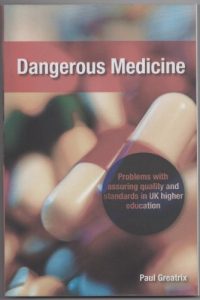Dangerous Medicine
This book, originally published in 2005, explores the origins of the quality assurance discourse in 20th Century higher education and argues that quality and standards are widely misunderstood concepts. This is manifested in the apparent enthusiasm for the adoption of industrial models of quality which are quite alien to education. The political context and justification for quality assurance are considered along with problems with language.
The absence of any evidential benefit of external quality frameworks is addressed and compared to the excessive cost of operating such systems. The programmatic imperative, that quality assurance systems must work, is shown to be corrosive of trust in universities. The debate about academic standards in the 1990s is discussed and the definitional difficulties in relation to standards are examined. It is argued that greater explicitness about standards, as urged by the 1997 Dearing report and exemplified by the NVQ model, causes significant problems. Standardisation, it is proposed, is all too often used inappropriately as a surrogate for standards.
These problematic strands converge towards the end of the 20th Century with the development of the Dearing-inspired QAA framework. Detailed scrutiny of the QAA proposals for a code of practice and benchmark statements on standards shows that the QAA model, even after modification, offers only the appearance of quality. The costs of the QAA framework outweigh any alleged value in terms of quality enhancement. Several alternative approaches are suggested, including the adoption of a suite of long-established proxies as an alternative to the QAA standards architecture. The QAA framework overall it is argued here offers only the prospect of decline and of damaging that which it is intended to assure; it is indeed dangerous medicine.
This book, originally published in 2005, explores the origins of the quality assurance discourse in 20th Century higher education and argues that quality and standards are widely misunderstood concepts. This is manifested in the apparent enthusiasm for the adoption of industrial models of quality which are quite alien to education. The political context and justification for quality assurance are considered along with problems with language.
The absence of any evidential benefit of external quality frameworks is addressed and compared to the excessive cost of operating such systems. The programmatic imperative, that quality assurance systems must work, is shown to be corrosive of trust in universities. The debate about academic standards in the 1990s is discussed and the definitional difficulties in relation to standards are examined. It is argued that greater explicitness about standards, as urged by the 1997 Dearing report and exemplified by the NVQ model, causes significant problems. Standardisation, it is proposed, is all too often used inappropriately as a surrogate for standards.
These problematic strands converge towards the end of the 20th Century with the development of the Dearing-inspired QAA framework. Detailed scrutiny of the QAA proposals for a code of practice and benchmark statements on standards shows that the QAA model, even after modification, offers only the appearance of quality. The costs of the QAA framework outweigh any alleged value in terms of quality enhancement. Several alternative approaches are suggested, including the adoption of a suite of long-established proxies as an alternative to the QAA standards architecture. The QAA framework overall it is argued here offers only the prospect of decline and of damaging that which it is intended to assure; it is indeed dangerous medicine.






